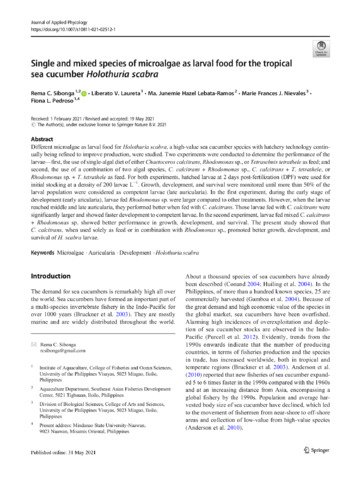Single and mixed species of microalgae as larval food for the tropical sea cucumber Holothuria scabra

រកមើល / បើក
កាលបរិច្ឆេទ
2021-05-31អ្នកនិពន្ធ
Page views
856ទិន្នន័យមេតា
មើលកំណត់ត្រាលម្អិតនៃធាតុCited times in Scopus
Share
អរូបី
Different microalgae as larval food for Holothuria scabra, a high-value sea cucumber species with hatchery technology continually being refined to improve production, were studied. Two experiments were conducted to determine the performance of the larvae—first, the use of single-algal diet of either Chaetoceros calcitrans, Rhodomonas sp., or Tetraselmis tetrathele as feed; and second, the use of a combination of two algal species, C. calcitrans + Rhodomonas sp., C. calcitrans + T. tetrathele, or Rhodomonas sp. + T. tetrathele as feed. For both experiments, hatched larvae at 2 days post-fertilization (DPF) were used for initial stocking at a density of 200 larvae L−1. Growth, development, and survival were monitored until more than 50% of the larval population were considered as competent larvae (late auricularia). In the first experiment, during the early stage of development (early aricularia), larvae fed Rhodomonas sp. were larger compared to other treatments. However, when the larvae reached middle and late auricularia, they performed better when fed with C. calcitrans. Those larvae fed with C. calcitrans were significantly larger and showed faster development to competent larvae. In the second experiment, larvae fed mixed C. calcitrans + Rhodomonas sp. showed better performance in growth, development, and survival. The present study showed that C. calcitrans, when used solely as feed or in combination with Rhodomonas sp., promoted better growth, development, and survival of H. scabra larvae.
Suggested Citation
Sibonga, R., Laureta, L. V., Lebata-Ramos, M. J. H., Nievales, M. F. J., & Pedroso, F. L. (2021). Single and mixed species of microalgae as larval food for the tropical sea cucumber Holothuria scabra. Journal of Applied Phycology , 33, 3103-3112. https://doi.org/10.1007/s10811-021-02512-1
ប្រធានបទ
Taxonomic term
បណ្តុំបណ្តុំ
- AQD Journal Articles [1249]
